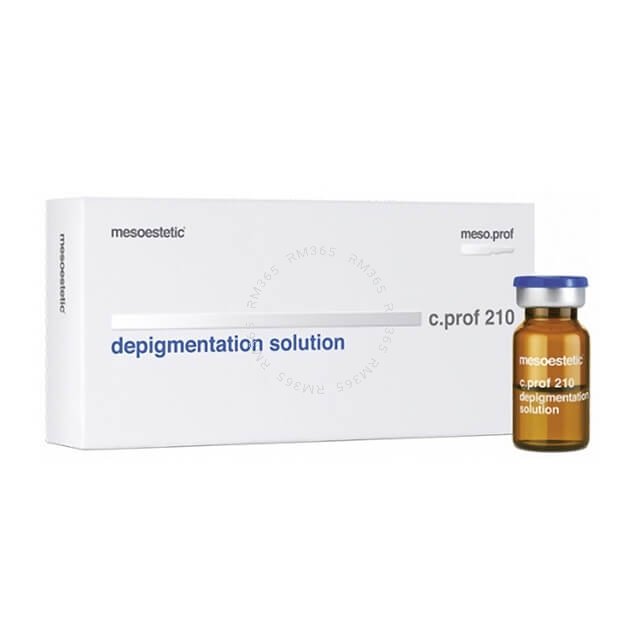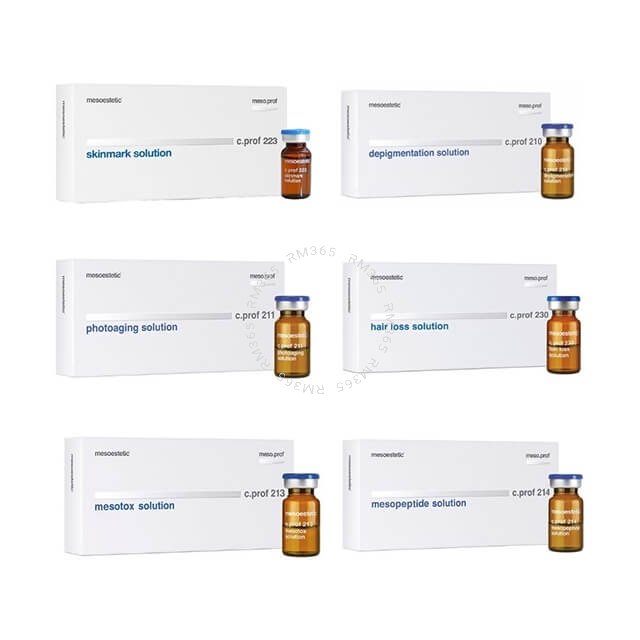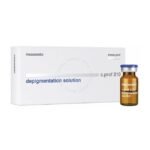MESOESTETIC C.PROF 210 DEPIGMENTATION SOLUTION (5 X 5ML)
Mesoestetic c.prof 210 depigmentation solution is a powerful combination of active ingredients with corrective action of pigment disorders and anti-oxidant. It acts regulating melanin production and removing the melanin present in epidermal cells, responsible for visible pigmentation. It also contains antioxidant agents that regulate melanin overproduction.
Treatment of moderate hyperpigmentation (solar or senile lentigo) or PIH (post-inflammatory hyperpigmentation) in fair and medium phototypes (I-III). Evens out skin tone. Provides brightness and vitality
Understanding Mesoestetic C.prof 210 Depigmentation Solution:
Key Components and Formulation:
- Ascorbic Acid (Vitamin C): Ascorbic acid is a powerful antioxidant that contributes to the brightening and evening of the skin tone. It helps to inhibit melanin production and reduce oxidative stress on the skin.
- Phytic Acid: Phytic acid, derived from rice, is known for its exfoliating properties. It helps to remove dead skin cells, promoting a more even skin tone and reducing the appearance of pigmentation.
- Niacinamide (Vitamin B3): Niacinamide is known for its anti-inflammatory and skin-brightening properties. It helps regulate melanin production and can be effective in addressing various forms of pigmentation.
- Ferulic Acid: Ferulic acid is an antioxidant that helps protect the skin from UV damage and environmental stressors. It can enhance the effectiveness of other ingredients in the formulation.
Benefits of Mesoestetic C.prof 210:
- Hyperpigmentation Reduction: The primary benefit of Mesoestetic C.prof 210 is its effectiveness in reducing hyperpigmentation, including dark spots, melasma, and post-inflammatory hyperpigmentation.
- Brightening Effect: The inclusion of ascorbic acid and other brightening agents helps brighten the complexion, giving the skin a luminous and refreshed appearance.
- Prevention of Future Pigmentation: Mesoestetic C.prof 210 not only addresses existing pigmentation issues but also works to prevent future hyperpigmentation by regulating melanin synthesis.
Application Process:
- Consultation: A thorough consultation with a qualified skincare professional is crucial before starting any depigmentation treatment. The professional will assess the individual’s skin type, pigmentation concerns, and medical history.
- Cleansing: The treatment area is cleansed to remove any makeup, oils, or impurities. This step ensures a clean surface for the application of the depigmentation solution.
- Post-Treatment Care: Patients are usually provided with post-treatment care instructions, which may include avoiding sun exposure, using sunscreen, and refraining from certain skincare products for a specified period.
- Follow-Up Sessions: The number of sessions required may vary depending on the severity of pigmentation and individual response. Skincare professionals often recommend a series of sessions spaced several weeks apart for optimal results.
Considerations and Potential Side Effects:
- Temporary Redness: Some individuals may experience mild redness at the treatment site, which typically subsides within a few hours to a day.
- Slight Peeling or Flaking: Exfoliating agents in the formulation may cause slight peeling or flaking of the skin as it sheds dead cells. This is a normal part of the depigmentation process.
- Individual Response: The effectiveness of the depigmentation solution can vary among individuals, and results may depend on factors such as skin type, pigmentation type, and adherence to post-treatment care.


























Reviews
There are no reviews yet.